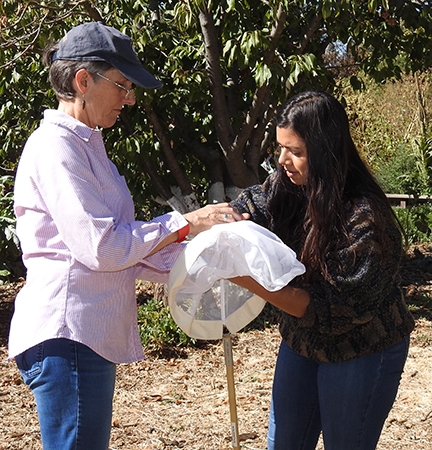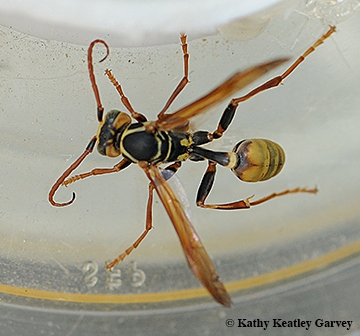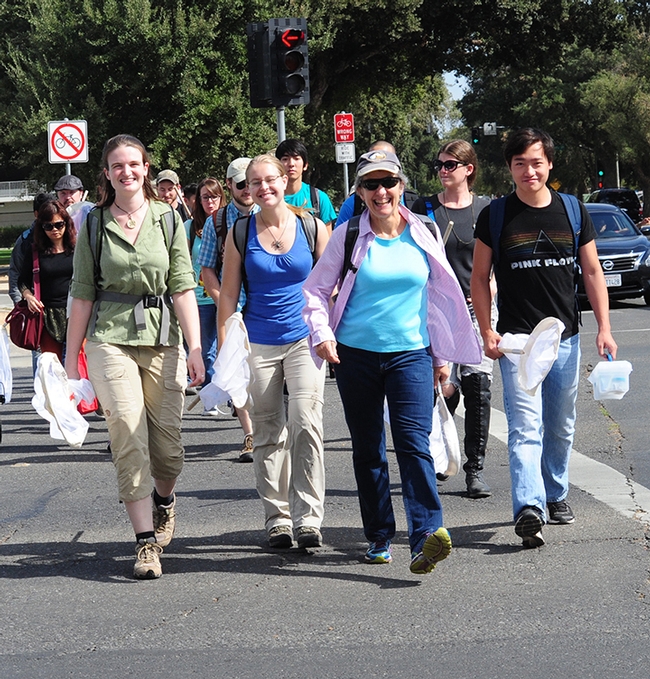
For the contest, Wilson performed a parody of "Billionaire" ("I Wanna Be a Billionaire") by Travie McCoy and Bruno Mars. She humorously titled it "I Wanna Be an Entomologist."
Watch and listen on YouTube.
Now it appears that the work of entomologists collecting insects in California may be in jeopardy...not to mention teachers in grades K-12 and in college.
Lynn Kimsey, director of the Bohart Museum of Entomology and UC Davis professor of entomology, this week proclaimed California's proposed permit rules for insect-collecting as not only “onerous and obtrusive” but will “obstruct the scientific work of researchers and teachers.“
"They amount to a mind-boggling, data-clogging nightmare,” she said.
“This is a major deal for scientific teaching and research,” Kimsey emphasized. “Teachers who assign their students to make insect collections will now have to apply for a permit, and only eight persons are allowed on any one permit. Plus, they have to notify California Fish and Wildlife 48 hours in advance before they collect, and inform them what exactly they will be collecting. It doesn't matter what they're studying—cockroaches, wasps or corn earworms.”
“This will make it even more difficult to study or teach about insects in California,” she said, adding that “Today, California is the only state in the U.S. that requires collecting permits to collect any terrestrial invertebrates, insects, slugs, millipedes, spiders, etc. anywhere in the state, private property, parks, federal lands, cities even, if it's being done for scientific research or teaching in K-12 and college. Ironically, there are no permit requirements for amateur collectors who can collect as much as they want.”
“These requirements,” she said, “will make research and teaching on invertebrates, particularly insects so difficult that it might very well stop our training in entomology and drive researchers to work out of state.”

Kimsey, who received her doctorate in entomology at UC Davis, has directed the Bohart Museum of Entomology, since 1990. The seventh largest insect collection in North America, it houses nearly eight million insect specimens (terrestrial and fresh water arthropods) collected globally. The museum is also home of the California Insect Survey, a storehouse of the insect biodiversity of California's deserts, mountains, coast, and the Great Central Valley. Founded in 1946 by its namesake and noted entomologist Richard M. Bohart (1913-2007) of UC Davis, the museum is dedicated to teaching, research and service.
In examining the proposed new rules for collecting insects, Kimsey cited seven crucial issues:
1. New Species. There may be as many as 100,000 species of terrestrial invertebrates in California and perhaps 6 percent are new to science. “This is far more species than we have the expertise in-state to identify,” she pointed out. “Sometimes it takes decades for someone to study a particular group. So it's impossible to give CDFW identifications much more detailed than Insecta for the permit paperwork.”
2. All Insects. These permit requirements apply whether “you're surveying the insects of a vernal pool or the distribution of dangerous invasive species, such as the yellow fever mosquito,” Kimsey said. “They also apply to the study of pest species, such as cockroaches and bedbugs.”
3. Bureaucracy. The required fees and detailed reports are onerous, obtrusive and seem to punish researchers and students studying and learning about insects, Kimsey declared. Permits take 6-8 weeks to be awarded and every time a change is needed, an emendation fee applies. “At UC Davis we are on the quarter system, which is 10 weeks. This means that a permit would be awarded by the time a class requiring students to make a collection is nearly over.”
4. Identification. “When we collect insects,” Kimsey explained, “we generally do not know what we've found until the material has been sorted, curated and identified to major group under the microscope--the vast majority of insects cannot be sight-identified and most are less than 1/4 inch long. This could take weeks and months. Specimens then need to be examined by experts who could be anywhere in the world.”
5. Chain of Custody. Every time the Bohart Museum of Entomology, home of nearly eight million insect specimens, ships specimens collected in California to an expert, “we would have to do CDFW chain-of-custody paperwork,” Kimsey said. “We take in an average of 30,000 specimens a year from university researchers and students. We loan up to 1,000 specimens a year to experts around the world. The paperwork would be crushing.”
6. Non-Target Insects. CDFW also requires permitees to account for by-catch, that is, non-target insects. “It's not clear if this includes insects collected on the radiator while driving in the study site,” she said.
7. Crime Scenes. Permits would also be required for the study of insects at crime scenes and any training that pertains to forensic entomology.
Kimsey said the simplest solution to this issue is “to simply remove terrestrial invertebrates from the permit requirements. But after the recent public meeting, that seems unlikely to happen.”
“We cannot see any benefit to the state in requiring permits for invertebrates when the information gained would be close to useless,” Kimsey declared. “California Wildlife and Wildlife informed us that the permit fees were necessary to cover the costs of dealing with the specimen data, but the data will not be useful and it would make much more sense to simply not cover terrestrial invertebrates.”
The entire data collection/permit process would result in a mind-boggling, data-clogging nightmare, she said. “If everyone in the state working on insects and teaching about them sent the specimen data to CDFW, they might be dealing with hundreds of thousands of data entries and thousands of reports annually, most of which would provide very little data. This amounts to an unfunded mandate, which will cost museums, scientists and teachers time and money. Museums would literally have to hire additional personnel to do the paperwork.”
Unfortunately, not many people were aware of the May 8 public hearing, but comments are continuing, although the department requested comments by 5 p.m., May 8, 2017, as outlined in the notice.
Contact information:
California Department of Fish and Wildlife
Regulations Unit - Scientific Collecting Permits
Attn: Ona Alminas, Environmental Scientist
1416 Ninth Street, Room 1342-A
Sacramento, CA 95814
Phone: 916-651-9167
Email: SCPermits@wildlife.ca.gov
Meanwhile, entomologists and other insect enthusiasts are weighing in this troubling issue on social media.
The comments include:
- "If California's bizarre new insect collecting regulations go through, it will effectively end entomology in that state."
- "This is absolutely horrific and pointless, I also wonder what the motivation is, who came up with this??"
- "Ironically, there are no permit requirements for amateur collectors who can collect as much as they want."
- "Will there be a special hot line? Hello? I would like to collect a cockroach this weekend. Ok you will need Form Pa111: permission to pick up and hold a cockroach; and Form Pa222: permission to detain a cockroach against its will!"
- "I love the fact that the permits are required only for scientific, educational, and non-commercial propagation purposes. So, if I wanted to collect butterflies to mount and sell, I could take as many as I wanted, no permit, notice, or paperwork required. But if I wanted to tag migratory butterflies and release them, I have to get a permit, give 48 hours notice, and maintain onerous amounts of paperwork."
- "I'm not a scientist and am only collecting these beautiful rare butterflies to feed to my frogs. No permit necessary." (said in jest)
- "We had to fill out more paperwork to collect and photograph common insects in Washington State National Forests than we did to study endangered invertebrates or endangered vertebrates!"
- "PA (Pennsylvania) was this way- for aquatic ecology we took a class field trip to get fishing permits to collect 'bait.'
Attached Images:
